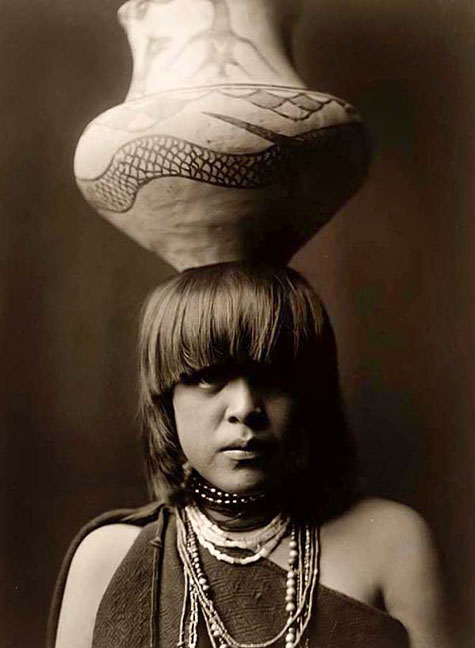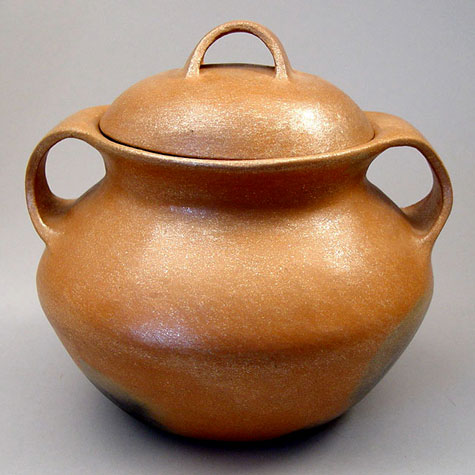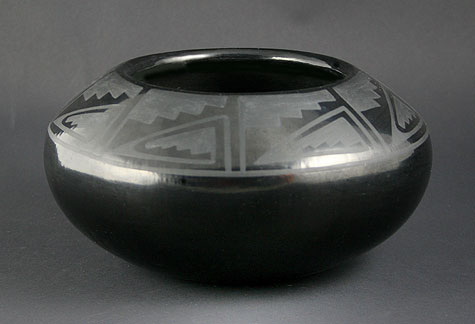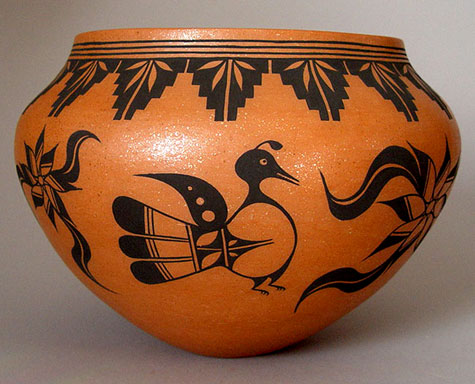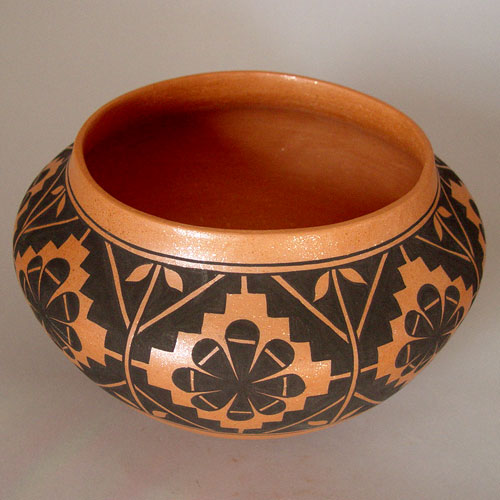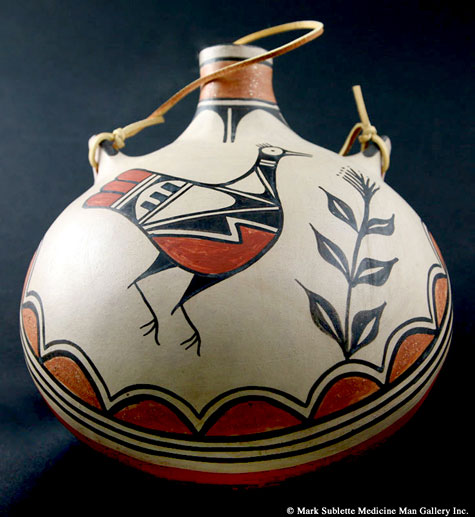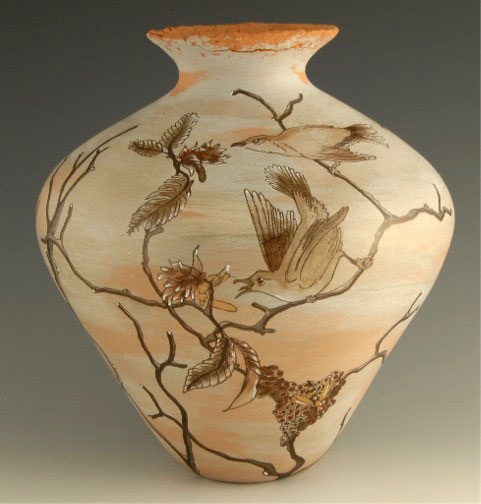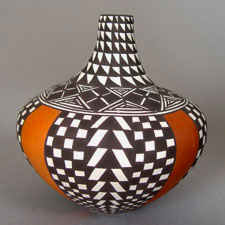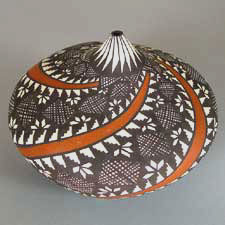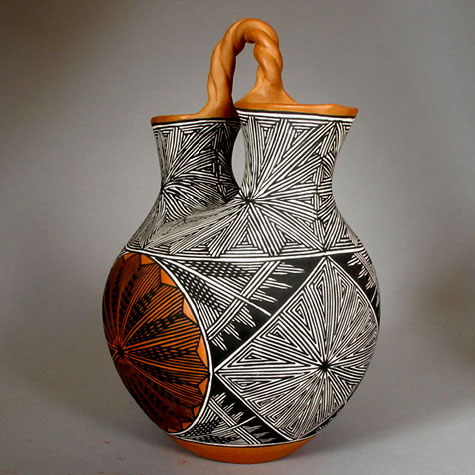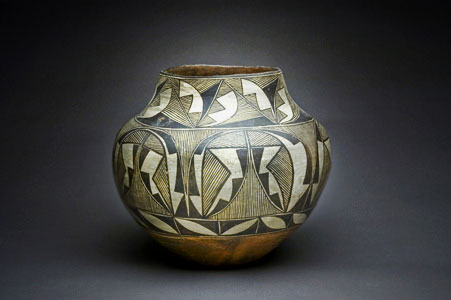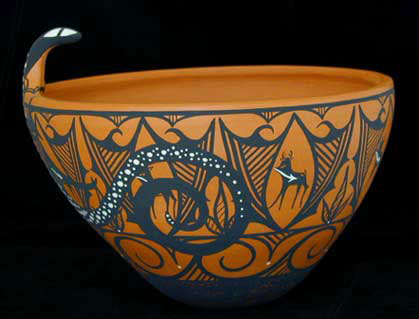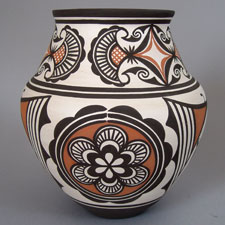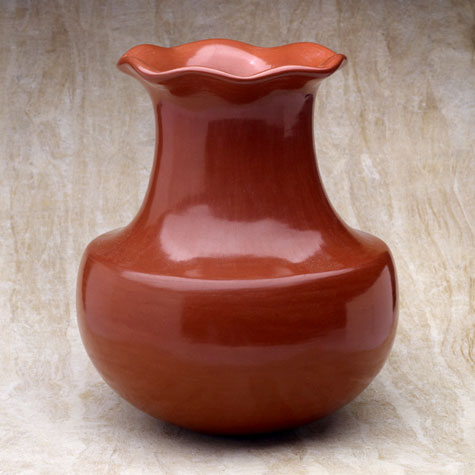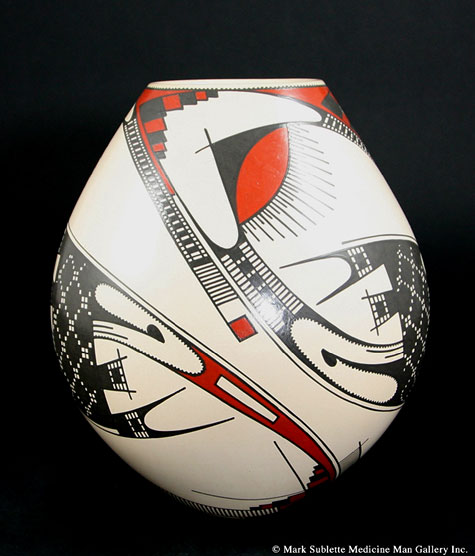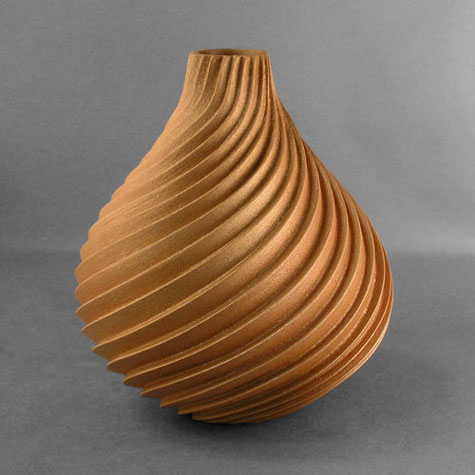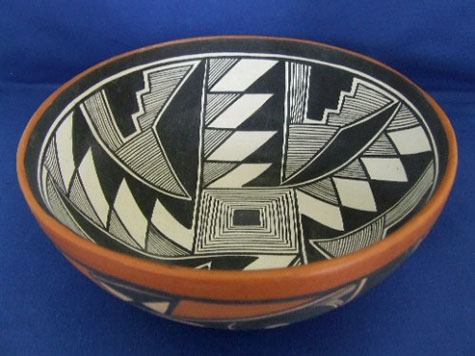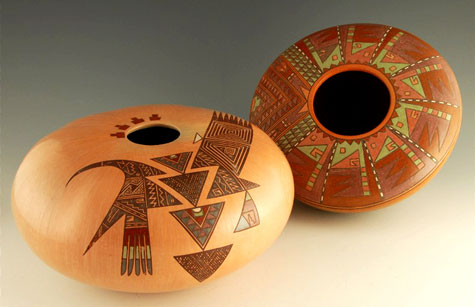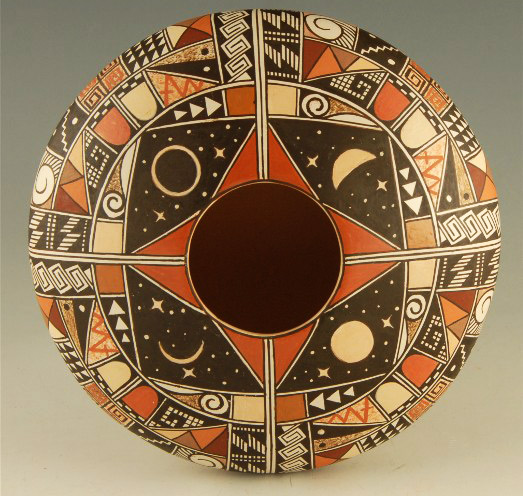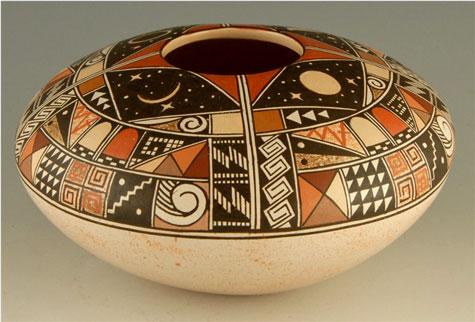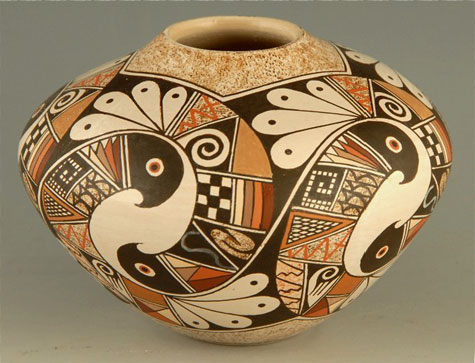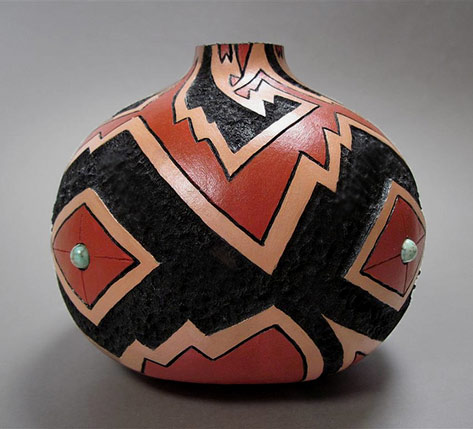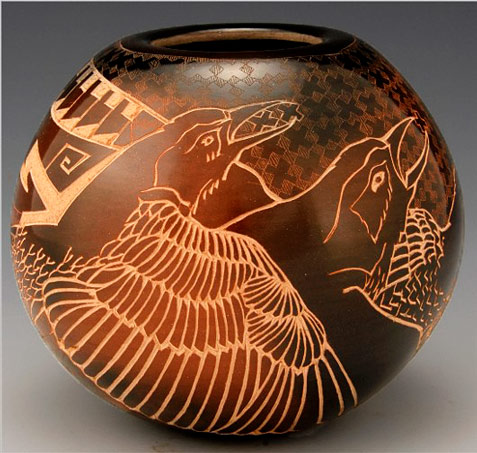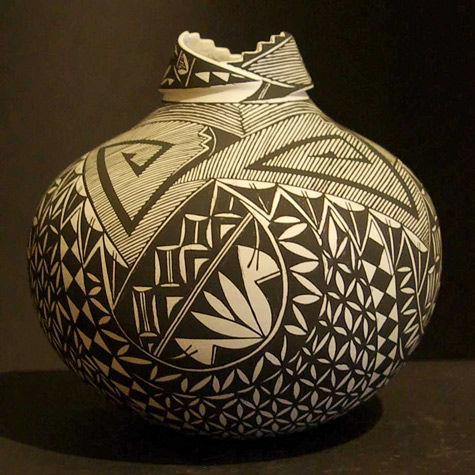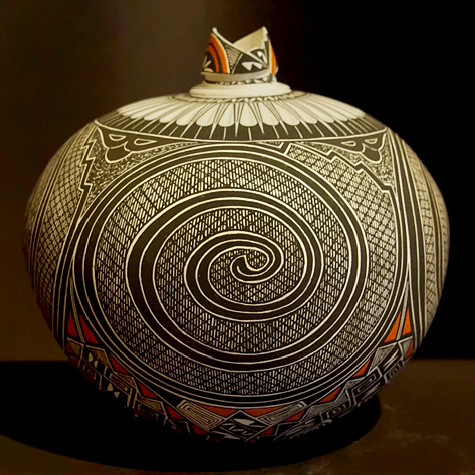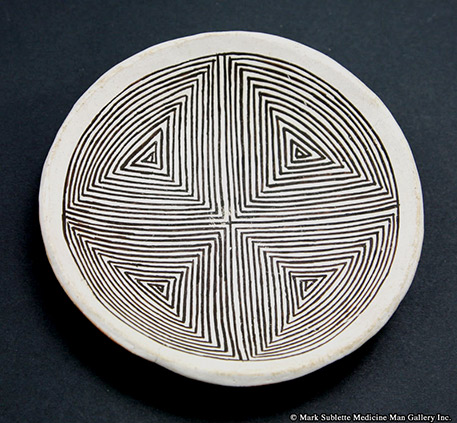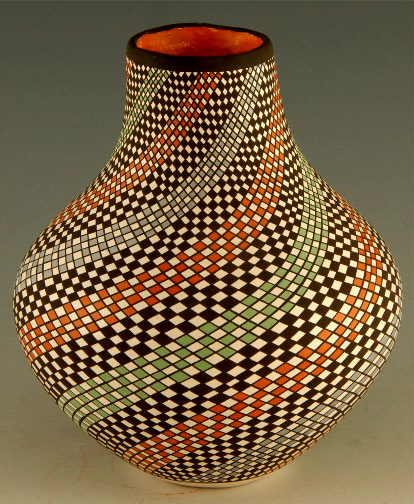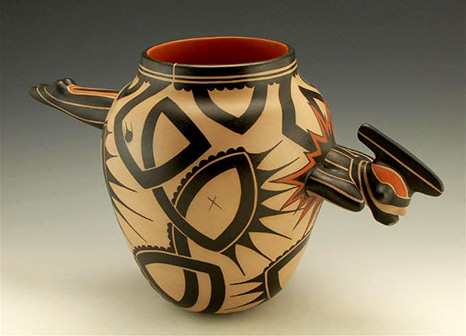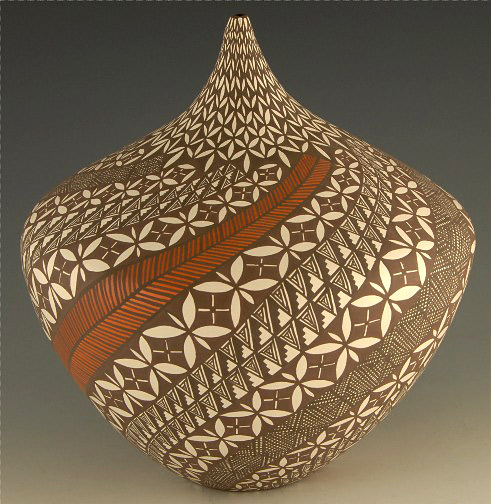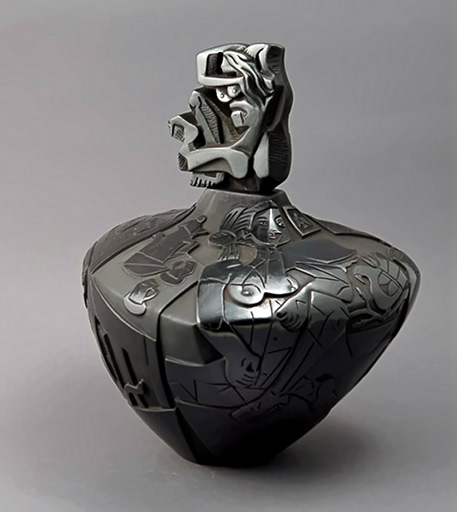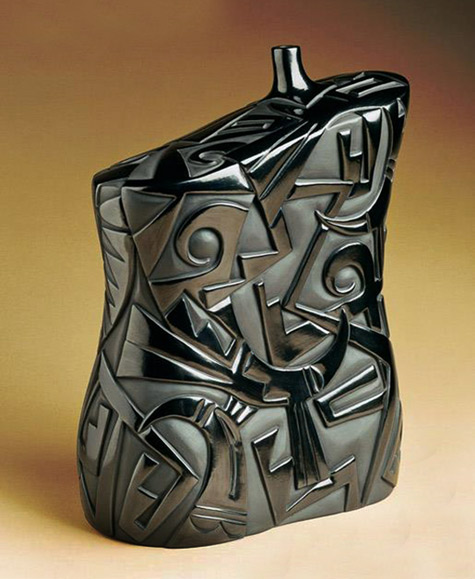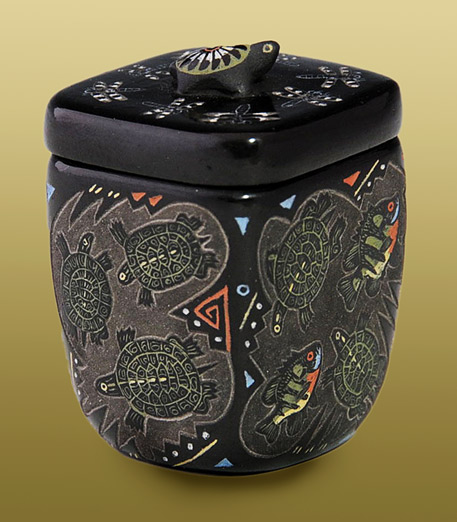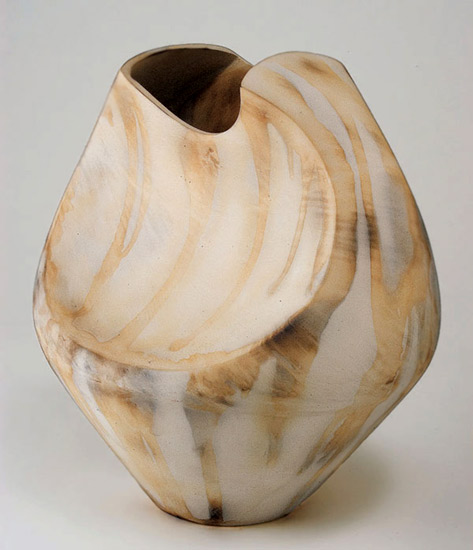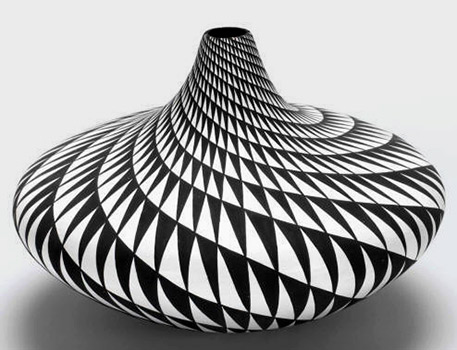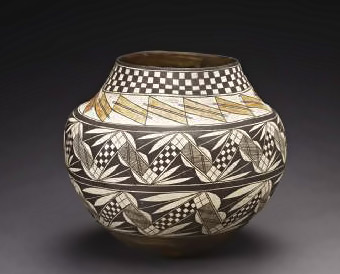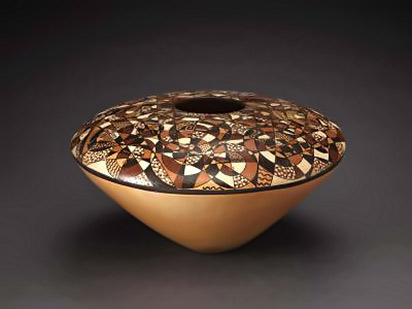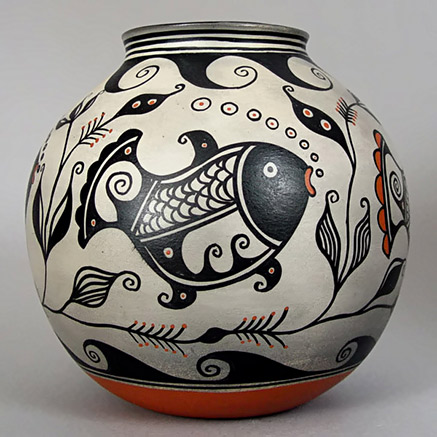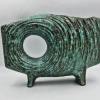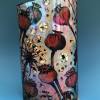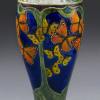San Ildefonso Girl with Jar
Photo by Edward S. Curtis
Karen Cordova –
Karen Cordova, Myrtle Cata of San Felipe and San Juan Pueblos. Micaceous Clay Pottery
Karen’s pots are hand coiled, traditionally pit fired, and built from clay gathered from historic clay pits where native peoples have gathered clays for hundreds of years. This style of pottery is indigenous to Taos and Picuris Pueblos. The clay is gathered in the summertime and the naturally present mica in the clay gives the pottery its beautiful glimmer.The
It can take two weeks to three months for each piece to be completed. The clay, in its natural environment, is dry like and dirt, but the experienced clay gatherer knows it on sight. The clay is soaked and strained before it can be worked. It is then coiled into shape. While it is drying designs may be etched into the clay. The pottery is then left in a dark room to slowly dry before firing.
Pots are fired in an open pit where they are placed on a grate. Then dry bark is built into a teepee formation around the pots and it is ignited from beneath. After two hours of being in the fire the pots are left to sit for another hour before the process is completed and the pottery is finished. ( http://www.pueblopotteryme.com )
Background to Pueblo Pottery :
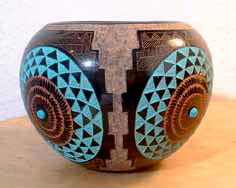 Hispanic, Native and Anglo Americans in New Mexico have made use of the market for ethnic art to express their artistic, religious and economic values. Spaniards arrived in the region by 1540 and encountered both hostile and helpful Pueblo Indians. One remarkable thing about the interactions between these cultures is that each has been able to preserve much of its unique character. After 1800, Anglo American culture added a third element to daily life in New Mexico. Hispanics and American Indians living along New Mexico’s Rio Grande Valley between Santa Fe and Taos have retained much of their culture, as reflected in such crafts as pottery, weaving, jewelry, and images.
Hispanic, Native and Anglo Americans in New Mexico have made use of the market for ethnic art to express their artistic, religious and economic values. Spaniards arrived in the region by 1540 and encountered both hostile and helpful Pueblo Indians. One remarkable thing about the interactions between these cultures is that each has been able to preserve much of its unique character. After 1800, Anglo American culture added a third element to daily life in New Mexico. Hispanics and American Indians living along New Mexico’s Rio Grande Valley between Santa Fe and Taos have retained much of their culture, as reflected in such crafts as pottery, weaving, jewelry, and images.
The Hispanics who settled in the mountainside village of Chimayó displaced the Indians after 1700, and are famous for their zig-zag and diamond woven designs.
After 1848, when much of Mexico became American territory, Anglo investors and promoters discovered and exploited the cultural practices and products of New Mexico’s Hispanics and Pueblo Indians. In turn, both groups sought ways to convert the tourism trade to their own benefits. While relying on the tourism market for income, many contemporary New Mexican artists use their work as a way of reaffirming old cultural values. Black, polished and carved pottery by Indians at Santa Clara Pueblo is still done by families, but also as individuals as a means of individual self expression.
By the 1920s, Pueblo potters experimented with forms and glazes, including the famous black-on-black finish developed by Maria Martinez of San Ildefonso Pueblo, who became the best known of all Indian potters among collectors.
Crucita Gonzales Calabaza
Crucita Gonzales Calabaza – ‘Blue Corn’
(1921-1999) – San Ildefonso Black on Black Geometric Bowl. Medicine Man Gallery.
Santo Domingo Pueblo :
Mark Wayne Garcia
Mark Wayne Garcia
Santo Domingo Pueblo, New Mexico
Mark Wayne Garcia
Mark has been an active Santo Domingo Pueblo potter since the 1990s working with black-on-red jars, dough bowls and canteens and most recently in micaceous pottery with black.
http://www.pueblopotteryme.com
Robert Tenorio —
Robert Tenorio
Canteen with stylized bird and corn design ( Medicine Man Gallery )
Santa Clara Peublo:
Santanita Suazo –
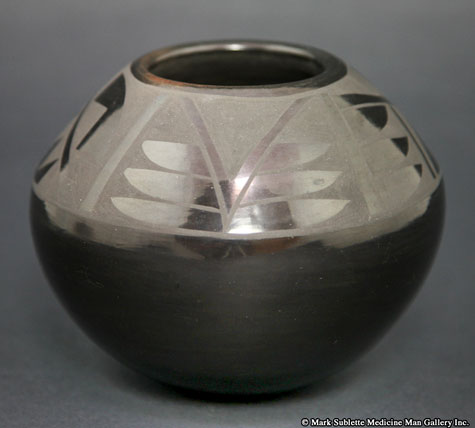 Black on Black Jar by Santanita Suazo
Black on Black Jar by Santanita Suazo
http://www.medicinemangallery.com
Susan Folwell —
Her innovative work was initially inspired by her mother, Jody Folwell, who broke many of the traditional conventions in the 1970’s. The jar below is slipped with a blue underglaze and then painted with birds and branches. The classic shape speaks well with the use of the birds and tree branches as they encircle the jar. The birds here are honeyguides or “honey birds which eat both the wax around the honey and the bee larvae. ( King Galleries )
Susan Folwell
Acoma Pueblo
Sandra M Victorino :
Sandra is one of today’s most highly collected potters along with her aunt and teacher, the famous Dorothy Torivio. She has won awards at the Santa Fe Indian Market.
Sandra M Victorino
Sandra M Victorino
.
Monroe Victorino :
Monroe has been an active potter since 1976 working with fineline polychrome bowls and jars. Monroe is well-known for his superb fineline work, wonderful star bursts a exemplified in the wedding vase below.
Monroe Victorino
Queaustea —
Josephine Foard, an arts and crafts do-gooder at the beginning of the twentieth century, thought that a larger market would develop for Pueblo pottery if the objects were glazed to be water tight.
She bought fine works like this Acoma jar by Queaustea, glazed it and sold it. However, the idea was never an economic success, and Pueblo pottery remains unglazed today.
Queaustea
Acoma Jar, 1900-1905 ( New Mexico Museum of Art )
Zuni Peublo :
Priscilla Peynesta
Priscilla Peynesta
A lizard rises over a repeating deer design. (www..pueblopottery.net )
Carlos Latte —
Carlos learned pottery making from his step-grandmother, Daisy Hooee, by observing and listening to his grandmother and what she had to say about pottery making. It was the same way with his aunt Jennie Laate. Carlos has been making pottery since 1989, and his technique continues to improve. His design elements cover all the traditional motifs: deer house, rosettes, rain birds, lines, curves, and geometrics.
Carlos Latte, Zuni Pueblo
Santa Clara Peublo :
Tina Garcia ( 1957-2005 )
Tine Garcia
The color of this traditional redware fluted pot is difficult to elaborate. It is not so much the pigment as the color saturation and the pristine gloss . Vessels like this classic shape with uninterrupted surfaces are harder to polish. Etched, carved, and shaped design elements provide natural break in finish—unadorned surfaces require uniform finish.
Marta Oritz Peublo :
Juan Quezada –
Mata Ortiz pottery is also known as Casa Grandes pottery as the pueblo is located along a tributary of the Rio Casas Grandes, a fertile valley which has long been inhabited by indigenous people. Pottery from this pueblo has seen a revival lead by the effort of Juan Quezada, a self taught potter of the modern Mata Ortiz style whose skills have attracted clay workers from the region, extended family and neighbors to create the distinctive pottery shapes and designs which define the pottery from this region. Many of the designs incorporate mimbres symbolism from Native American culture. Mata Ortiz pottery has become highly collectible .
Juan Quezada, Mata Ortiz
Medicine Man gallery
Jemez Peublo :
Dominique Toya
A fourth-generation, award -winning potter who has emerged as a major talent. Great-grandmother Persingula Gachupin, grandmother Marie G. Romero, mother Maxine Toya and aunt Laura Gachupin all paved the way for the artist’s very contemporary sensibility, based on age-old tradition.
Dominique Toya
Wright’s Indian Art
Verda Toledo —
Verda Toledo
=
Hopi Peublo :
Nathan Begaye ( 1958 – 2010 )
Nathan Begaye was an unique innovator among Pueblo and Navajo potters. His work used traditional designs, forms and techniques, yet somehow appeared very modern. His ethnic connection to both Hopi and Navajo let his work flow between the two distinctive styles and yet find their own unique space. Here are two classic pieces of his pottery. ( http://www.kinggalleries.com )
Nathan Begaye ‘Melon Bowls’
Rainy Naha-Hopi Tewa – Rainy Naha creates beautifully coiled pottery which is thin walled and traditionally fired. The white color is a white clay slip which is polished onto the surface of the clay. Her designs are all painted using natural clay slips for the various colors, or bee-weed (a plant) for the black. On the seedpot below is her classic solstice pattern. In the sections near the opening are the various phases of the moon. In the smaller panels below the moons are cloud, rain and traditional Hopi designs from both pottery and katsinas.
Rainy Naha ‘Solstice Bowl’
Rainy-Naha Solstice Bowl
The jar below has her “tumbling parrot” design. There are five parrots, which are interconnected and “tumbling” around the jar. Why parrots? They are one of the clans at Hopi and are typically seen in katsina form and their feathers are often used in the ceremonies. Rainy learned to make pottery from her mother, Helen (Featherwoman) Naha. Rainy continues to innovate and also create her own voice among Hopi-Tewa potters. ( King Galleries )
Rainy Naha ‘Tumbling Parrots’ Jar.
‘Earth Song’ is a carved and painted gourd done in the style of ancient Pueblo pottery.
Kaia Thomas
Bowl with Birds – Jody Folwell
Shauna Rustin Acoma via Andrea Fisher Pottery
Shauna Rustin Acoma, New Mexico
Geometric motif bowl
Mark Sublette – Medicine Man Gallery
Sharon Lewis – Swirling Squares Jar
Virgil Ortiz – ‘Velocity Jar’
Sandra Victorino – Tall Butte
Pottery by Tammy Garcia
Carved pottery bottle by Tammy Garcia
Jennifer Moquino, Santa Clara
Alan Lasiloo
Alan Lasiloo excavates the white clay of the Zuni Pueblo from the same location his grandmother collected clay for her pottery. In 1999, upon returning to the Pueblo after studying fashion design at the American College for the Applied Arts in Los Angeles, Lasiloo began altering traditional pottery forms. “I realized clay could be used like fabric. I used what I learned from fashion design about lines, curves, and pleats. It brought life to my pieces “
Dorothy Torivio “eye dazzler” seed jar.
Storage jar (olla), ca. 1890–1910
Jacob Koopee, American Hopi ( 1970 – 2011 )
T. Tenorio

